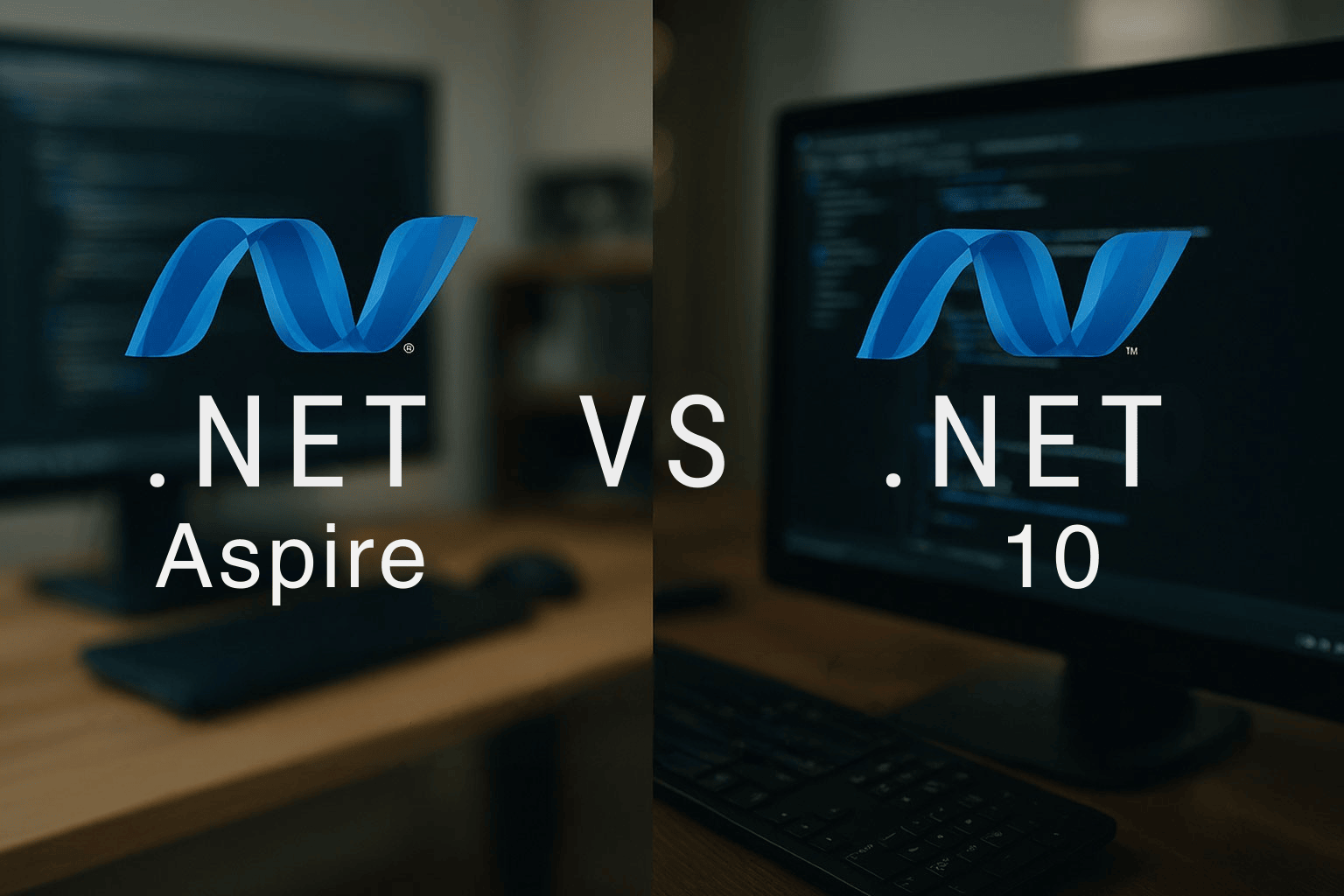.NET Aspire vs .NET 10: The Future of App Development and What Businesses Need to Know in 2025

29 Sep 2025
The software development sector is changing more rapidly, and 2025 is one of those milestone years of the .NET ecosystem. A new framework called Aspire was recently launched by Microsoft, which is an advanced framework aimed at simplifying and speeding up application development in the modern world. In the meantime, the latest development of the .NET framework, .NET 10, introduces new capabilities to create robust and business-friendly applications designed to withstand the future.
For businesses and developers, the big question is: “.NET Aspire vs .NET 10; which is right for you?”
When it comes to making informed decisions about technology investments, application scalability, and long-term growth, one needs to know the differences between the two frameworks.
The Growing Importance of .NET in 2025
In the last twenty years, the .NET frameworks of Microsoft have been the foundation of a variety of enterprise and consumer applications. .NET has come a long way, starting with web applications, cloud-native services, and so on.
Speed, scalability, and seamless integration are the new focus in 2025. Businesses also desire applications that are not just efficient but must also be future-proof and be able to deal with new technologies such as AI, IoT, and modern cloud infrastructure.
Both .NET Aspire and .NET 10 are signs of this vision, but are needed differently in the .NET ecosystem.
What is .NET Aspire?
The new cloud-native and app-oriented framework by Microsoft, named .NET Aspire, was released to assist developers in creating distributed and scalable applications at a quicker rate. It is designed with ease and agility in consideration, specifically towards the teams that have microservices and cloud-based applications.
Key .NET Aspire Features:
- Rapid Development: The tools and templates are streamlined to build more quickly.
- Cloud-Native Ready: Especially designed for Azure, but good for other leading platforms as well.
- Ready-To-Use Integrations: Integrate easily with APIs, databases, and third-party services.
- Made work easier: Easier DevOps integration with continuous delivery.
- Next-Gen Developer Experience: Improvement in Visual Studio for modern workflows.
Consider it to be the start-up friendliness of .NET Aspire, ideal when agile teams require the ability to innovate fast, without heavy infrastructure management.
What is .NET 10?
The most recent version of the Microsoft flagship .NET platform is known as .NET 10, and it introduces better performance and additional features to support a great enterprise-level program. It is best suited to companies that require stability, scale, and longevity.
Key .NET 10 New Features:
- Performance Enhances: Optimized performance in order to execute faster and use fewer resources.
- AI and ML Integration: In-built support of AI-based applications and predictive analytics.
- Advanced Security: Inbuilt features to secure the confidential company information.
- Cross-Platform Expansion: Seamless deployment across Windows, macOS, Linux, and mobile platforms.
- Enterprise Reliability: Long support time on mission-critical applications.
In case of innovation speed with .NET Aspire, the enterprise resilience and performance of .NET 10 should be referred to.
.NET Aspire vs .NET 10: Key Differences
Here’s a side-by-side comparison to help you see where these frameworks stand apart:
| Feature | .NET Aspire | .NET 10 |
| Primary Use Case |
Cloud-native, agile app development |
Enterprise-grade, mission-critical apps |
| Deployment Focus |
Microservices and distributed systems |
Large-scale, multi-platform deployments |
| Speed vs Stability |
Prioritizes rapid innovation and flexibility |
Focuses on performance, security, and long-term support |
| Ideal For |
Startups, SaaS products, experimental apps |
Established enterprises, government, and finance |
| Cloud Integration |
Deep integration with Azure and cloud services |
Broad multi-platform compatibility |
| AI/ML Features |
External integration required |
Built-in support for AI-driven apps |
Which is Better: .NET Aspire or .NET 10?
The answer depends entirely on your business goals and development strategy.
- Choose .NET Aspire if:
- You’re a startup or small business looking to innovate quickly.
- Your team is focused on building cloud-native applications or SaaS products.
- Speed-to-market matters more than legacy support.
- You’re a startup or small business looking to innovate quickly.
- Choose .NET 10 if:
- You’re managing enterprise-level systems with complex integrations.
- Security and compliance are top priorities (e.g., healthcare, finance).
- You need future-proof app development with multi-year support from Microsoft.
- You’re managing enterprise-level systems with complex integrations.
Many businesses may even use both frameworks, leveraging .NET Aspire for rapid prototyping and innovation, while relying on .NET 10 for stable, production-grade systems.
Why This Matters for Businesses in 2025
The 2025 future of app development is all about the balancing of innovation and stability. Businesses can neither afford to use the old tools, nor can take chances to adopt a new technology without a clear plan.
- .NET Aspire is the future of frameworks for developing apps that are agile and experimental.
- .NET 10 builds on the growth of the Microsoft ecosystem, with comfortable building blocks to scale to digital transformation.
Knowing the advantages of each framework, companies can support their technology decision with their developmental path.
Future-Proofing Your Applications with .NET
Whether you choose Aspire or .NET 10, your long-term success depends on future-proof app development with .NET. Here’s how to prepare:
- Evaluate Your Existing Stack: Determine what old systems can be brought up to date.
- Create Cross-Platform Development: Develop apps that are everywhere, whether on the web or mobile.
- Use AI and Data Analytics: There are new AI capabilities in .NET 10 that can be used to gain a competitive advantage.
- Scalability: Cloud-native architecture is necessary to scale.
- Collaborate with Experts: Collaborate with skilled .NET developers to ensure high ROI.
Performance Comparison: Aspire vs .NET 10
When it comes to .NET Aspire vs .NET 10 performance comparison, here’s what we’ve seen:
- Aspire is best in development speed and lightweight deployments, ideal for fast-moving startups.
- .NET 10 is the leading runtime in terms of performance, supporting massive transaction volumes and enterprise workloads.
This makes Aspire ideal for innovation and prototyping, while .NET 10 is better for long-term scalability and high-performance apps.
Final Thoughts
2025 is a milestone for the .NET ecosystem as it will give businesses more options than ever.
- .NET Aspire is all about agility, which enables teams to innovate within a short time frame.
- .NET 10 is all about reliability and enterprise-scale power.
When it comes to picking either one of the two, it is not about which one is, overall, a better choice, but choosing which framework fits your business vision and technical needs.
Through knowledge and strategic planning, you can use the two frameworks to create modern and future-ready applications that can continue to grow in the coming years.



.jpeg)

